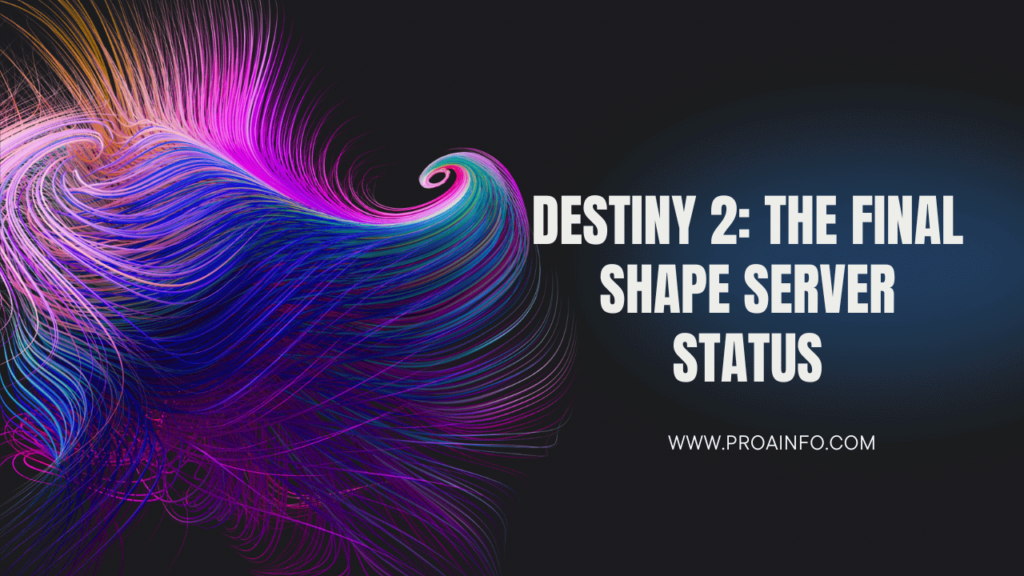Destiny 2: The Final Shape Server Status. The release of Destiny 2’s highly anticipated expansion, The Final Shape, has sent shockwaves through the gaming community. As Guardians brace themselves for the epic conclusion to the Light and Darkness saga, the server status becomes a critical factor in ensuring a seamless and immersive experience.
In this comprehensive article, we delve into the intricacies of the server infrastructure, the challenges faced during high-demand periods, and the strategies employed by Bungie to ensure a stable and reliable gaming environment.
The Significance of Server Status
In the vast and interconnected world of Destiny 2, server status plays a pivotal role in determining the overall quality of gameplay. Stable servers are essential for facilitating smooth online interactions, enabling Guardians to engage in cooperative activities, participate in high-stakes battles, and explore the vast expanses of the game’s universe without interruption. Conversely, server issues can lead to frustrating disconnections, laggy gameplay, and a diminished overall experience.
The Complexities of Server Infrastructure
Maintaining a robust server infrastructure for a game as massive and popular as Destiny 2 is no small feat. Bungie’s engineers and network administrators work tirelessly to ensure that the servers can handle the immense load of players during peak hours, content releases, and highly anticipated events. The server architecture must be scalable, resilient, and capable of handling millions of concurrent connections while minimizing latency and ensuring data integrity.
Destiny 2’s server infrastructure is a complex ecosystem comprising various components, including game servers, authentication servers, matchmaking servers, and content delivery networks (CDNs). Each component plays a crucial role in facilitating different aspects of the gaming experience, from hosting gameplay instances to authenticating player credentials and delivering updates and downloadable content.
The Challenges of High-Demand Periods
One of the most significant challenges faced by Bungie’s server infrastructure is the surge in player activity during high-demand periods, such as the release of a major expansion like The Final Shape. These periods often coincide with an influx of new and returning players, placing unprecedented strain on the servers. Bungie’s network engineers must carefully plan and implement strategies to ensure that the servers can handle the increased load without compromising performance or stability.
Strategies for Ensuring Server Stability
Bungie employs a range of strategies to maintain server stability and prevent outages during high-demand periods. These strategies include:
- Server Scaling
Bungie’s server infrastructure is designed to be highly scalable, allowing for the dynamic allocation of additional resources to accommodate increased player activity. This process, known as server scaling, involves provisioning and deploying new game servers, authentication servers, and other components to distribute the load and prevent bottlenecks. - Load Balancing
Load balancing is a crucial technique employed by Bungie to distribute incoming traffic across multiple servers, ensuring that no single server becomes overwhelmed. Advanced load balancing algorithms continuously monitor server loads and intelligently route traffic to the most appropriate servers, optimizing resource utilization and minimizing response times. - Content Delivery Networks (CDNs)
To ensure efficient content delivery, Bungie leverages the power of CDNs, which are globally distributed networks of servers designed to deliver digital content rapidly and reliably. By caching game assets and updates on servers located closer to players’ geographical locations, CDNs minimize latency and reduce the load on Bungie’s primary servers. - Maintenance and Monitoring
Proactive maintenance and continuous monitoring are essential components of Bungie’s server management strategy. Regular updates, patches, and hardware upgrades are deployed to address potential vulnerabilities, optimize performance, and incorporate the latest security measures. Additionally, Bungie’s network operations team closely monitors server health and performance metrics, enabling them to quickly identify and address any emerging issues.
The Role of Communication and Transparency
Effective communication and transparency play a crucial role in managing player expectations and fostering trust within the Destiny 2 community. Bungie maintains multiple channels, including social media platforms, official forums, and in-game messaging systems, to keep players informed about server status, potential issues, and ongoing maintenance activities.
During high-demand periods or in the event of server outages, Bungie’s community managers and technical support teams work diligently to provide timely updates, acknowledging the issue, and providing estimated resolution times. This open communication helps alleviate frustration and ensures that players have the information they need to plan their gaming sessions accordingly.
The Future of Server Infrastructure
As the Destiny 2 universe continues to expand and evolve, Bungie remains committed to investing in cutting-edge server technologies and infrastructure improvements to ensure a seamless and engaging experience for Guardians. The advent of cloud computing, edge computing, and advanced networking technologies opens up new possibilities for optimizing server performance, reducing latency, and enhancing overall scalability.
Bungie’s engineers are constantly exploring and evaluating emerging technologies, such as containerization, serverless architectures, and software-defined networking, to future-proof the server infrastructure and stay ahead of the increasing demands of the game’s growing player base.
Conclusion
The release of Destiny 2: The Final Shape marks a significant milestone in the game’s narrative, and the server status plays a crucial role in ensuring that Guardians can fully immerse themselves in the epic conclusion. Bungie’s dedication to maintaining a robust and reliable server infrastructure, coupled with their commitment to open communication and transparency, demonstrates their unwavering support for the Destiny 2 community.
As players embark on this final chapter of the Light and Darkness saga, they can rest assured that Bungie’s network engineers and support teams are working tirelessly behind the scenes to deliver a seamless and unforgettable gaming experience. With the server infrastructure poised to handle the influx of players and the community eagerly awaiting the epic conclusion, the stage is set for an unforgettable journey through the realms of Destiny 2: The Final Shape.
FAQs
Q: What is the current server status for Destiny 2: The Final Shape?
A: Bungie provides real-time updates on the server status for Destiny 2, including The Final Shape expansion, through their official website (www.bungie.net) and social media channels (Twitter: @BungieHelp, @DestinyTheGame). Players can check these channels for the latest information on server availability, maintenance schedules, and any potential issues or outages.
Q: Why do server issues occur during major content releases like The Final Shape?
A: During the release of highly anticipated expansions or updates, Destiny 2 experiences a significant surge in player activity, placing immense strain on the server infrastructure. The influx of new and returning players, coupled with the increased demand for content downloads and gameplay instances, can overwhelm the servers, leading to potential performance issues or temporary outages.
Q: What steps does Bungie take to ensure server stability during high-demand periods?
A: Bungie employs various strategies to maintain server stability, including server scaling (dynamically allocating additional resources), load balancing (distributing traffic across multiple servers), leveraging content delivery networks (CDNs) for efficient content delivery, and implementing proactive maintenance and continuous monitoring.
Q: How can I check the server status for my specific region or platform?
A: Bungie’s server status updates typically provide information specific to different regions and platforms. Players can visit the official website or follow the designated social media channels for their region (e.g., @BungieHelp for North America, @BungieHelpEU for Europe) to get the most up-to-date and relevant information.
Q: What should I do if I experience connectivity issues or lag during gameplay?
A: If you encounter connectivity issues or lag while playing Destiny 2: The Final Shape, try restarting your game client or console, checking your internet connection, and consulting Bungie’s support resources for troubleshooting steps. Additionally, you can report the issue through the official support channels to help Bungie’s team investigate and address the problem.
Q: How can I stay informed about scheduled maintenance or planned downtime?
A: Bungie typically announces scheduled maintenance or planned downtime well in advance through their official channels, such as the website, social media, and in-game messaging systems. Players can follow these channels to receive timely notifications and plan their gaming sessions accordingly.
Q: Does Bungie provide any compensation or make-good for extended server outages?
A: While Bungie strives to minimize server disruptions, extended outages or significant performance issues may prompt the company to offer compensation or make-good gestures to affected players. These gestures can range from in-game rewards or resources to extending the duration of ongoing events or activities. Details about such compensation are typically communicated through official channels.
Q: How can I contribute to improving the server infrastructure or report server-related issues?
A: Bungie values player feedback and encourages the community to report any server-related issues or concerns through the official support channels, such as the Help Forum or the #Help forum on the Bungie.net website. Providing detailed information about the issues encountered can help Bungie’s engineers identify and address the underlying problems more effectively.







